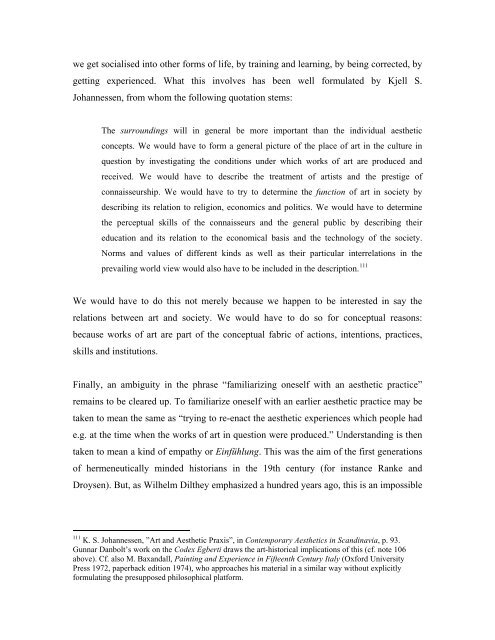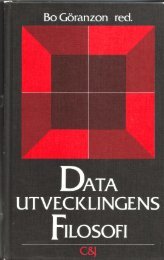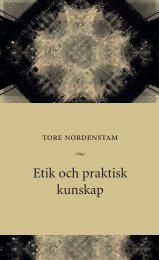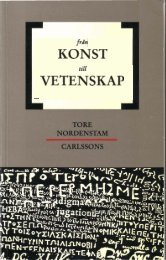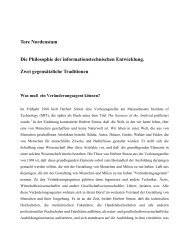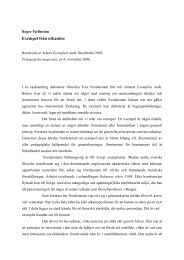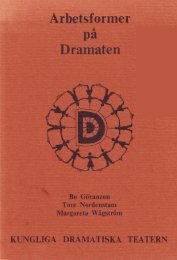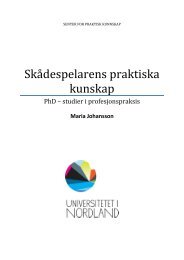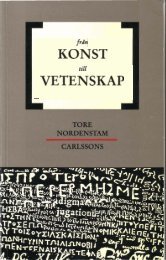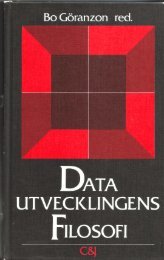tore nordenstam explanation and understanding in the history of art
tore nordenstam explanation and understanding in the history of art
tore nordenstam explanation and understanding in the history of art
You also want an ePaper? Increase the reach of your titles
YUMPU automatically turns print PDFs into web optimized ePapers that Google loves.
we get socialised <strong>in</strong>to o<strong>the</strong>r forms <strong>of</strong> life, by tra<strong>in</strong><strong>in</strong>g <strong>and</strong> learn<strong>in</strong>g, by be<strong>in</strong>g corrected, by<br />
gett<strong>in</strong>g experienced. What this <strong>in</strong>volves has been well formulated by Kjell S.<br />
Johannessen, from whom <strong>the</strong> follow<strong>in</strong>g quotation stems:<br />
The surround<strong>in</strong>gs will <strong>in</strong> general be more important than <strong>the</strong> <strong>in</strong>dividual aes<strong>the</strong>tic<br />
concepts. We would have to form a general picture <strong>of</strong> <strong>the</strong> place <strong>of</strong> <strong>art</strong> <strong>in</strong> <strong>the</strong> culture <strong>in</strong><br />
question by <strong>in</strong>vestigat<strong>in</strong>g <strong>the</strong> conditions under which works <strong>of</strong> <strong>art</strong> are produced <strong>and</strong><br />
received. We would have to describe <strong>the</strong> treatment <strong>of</strong> <strong>art</strong>ists <strong>and</strong> <strong>the</strong> prestige <strong>of</strong><br />
connaisseurship. We would have to try to determ<strong>in</strong>e <strong>the</strong> function <strong>of</strong> <strong>art</strong> <strong>in</strong> society by<br />
describ<strong>in</strong>g its relation to religion, economics <strong>and</strong> politics. We would have to determ<strong>in</strong>e<br />
<strong>the</strong> perceptual skills <strong>of</strong> <strong>the</strong> connaisseurs <strong>and</strong> <strong>the</strong> general public by describ<strong>in</strong>g <strong>the</strong>ir<br />
education <strong>and</strong> its relation to <strong>the</strong> economical basis <strong>and</strong> <strong>the</strong> technology <strong>of</strong> <strong>the</strong> society.<br />
Norms <strong>and</strong> values <strong>of</strong> different k<strong>in</strong>ds as well as <strong>the</strong>ir p<strong>art</strong>icular <strong>in</strong>terrelations <strong>in</strong> <strong>the</strong><br />
prevail<strong>in</strong>g world view would also have to be <strong>in</strong>cluded <strong>in</strong> <strong>the</strong> description. 111<br />
We would have to do this not merely because we happen to be <strong>in</strong>terested <strong>in</strong> say <strong>the</strong><br />
relations between <strong>art</strong> <strong>and</strong> society. We would have to do so for conceptual reasons:<br />
because works <strong>of</strong> <strong>art</strong> are p<strong>art</strong> <strong>of</strong> <strong>the</strong> conceptual fabric <strong>of</strong> actions, <strong>in</strong>tentions, practices,<br />
skills <strong>and</strong> <strong>in</strong>stitutions.<br />
F<strong>in</strong>ally, an ambiguity <strong>in</strong> <strong>the</strong> phrase “familiariz<strong>in</strong>g oneself with an aes<strong>the</strong>tic practice”<br />
rema<strong>in</strong>s to be cleared up. To familiarize oneself with an earlier aes<strong>the</strong>tic practice may be<br />
taken to mean <strong>the</strong> same as “try<strong>in</strong>g to re-enact <strong>the</strong> aes<strong>the</strong>tic experiences which people had<br />
e.g. at <strong>the</strong> time when <strong>the</strong> works <strong>of</strong> <strong>art</strong> <strong>in</strong> question were produced.” Underst<strong>and</strong><strong>in</strong>g is <strong>the</strong>n<br />
taken to mean a k<strong>in</strong>d <strong>of</strong> empathy or E<strong>in</strong>fühlung. This was <strong>the</strong> aim <strong>of</strong> <strong>the</strong> first generations<br />
<strong>of</strong> hermeneutically m<strong>in</strong>ded historians <strong>in</strong> <strong>the</strong> 19th century (for <strong>in</strong>stance Ranke <strong>and</strong><br />
Droysen). But, as Wilhelm Dil<strong>the</strong>y emphasized a hundred years ago, this is an impossible<br />
111 K. S. Johannessen, ”Art <strong>and</strong> Aes<strong>the</strong>tic Praxis”, <strong>in</strong> Contemporary Aes<strong>the</strong>tics <strong>in</strong> Sc<strong>and</strong><strong>in</strong>avia, p. 93.<br />
Gunnar Danbolt’s work on <strong>the</strong> Codex Egberti draws <strong>the</strong> <strong>art</strong>-historical implications <strong>of</strong> this (cf. note 106<br />
above). Cf. also M. Bax<strong>and</strong>all, Pa<strong>in</strong>t<strong>in</strong>g <strong>and</strong> Experience <strong>in</strong> Fifteenth Century Italy (Oxford University<br />
Press 1972, paperback edition 1974), who approaches his material <strong>in</strong> a similar way without explicitly<br />
formulat<strong>in</strong>g <strong>the</strong> presupposed philosophical platform.


